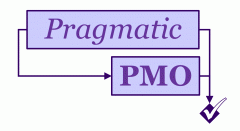How we helped a project team to improve quality and predictability based on delivery experience
The situation
- Pragmatic PMO was engaged to provide delivery support to a multi-year programme to refit a global HQ building whilst still in occupation.
- As the building was to remain occupied throughout, the works were to take place in a series of phases.
- The programme that had no schedule in place.
- Most of the workstream leads were operational people with a deep understanding of the business but with little or no experience of planning projects.
The target
- The aim was to create an overall view of activity within the programme, and provide an ability to predict delivery dates.
The approach
- We liaised with project managers and workstream leads to understand their plans and dependencies, and their planning expertise (hence the level of support needed)
- We realised the programme wasn’t a simple chain of projects, with B starting after A had completed.
- We built an integrated MS Project schedule connecting early projects’ outputs as inputs to later projects
- We realised that as the phases would be similar to each other and broadly sequential, there was an opportunity to apply learning from early phases to later phases.
- We ran lessons learned workshops on early phases, and identified a set of standard “cookie cutter” client activities that would need to be carried out for every phase.
- We applied these to later phases as a template that could be tailored for each phase.
The result
- Within a month, had in place a summarised schedule of the programme’s projects, key dates and dependencies.
- Within three months, had in place a detailed schedule dynamically modelling project activities and dependencies, with filters to show e.g. the next four weeks and any late activities for a given project manager or workstream lead.
- We identified over-reliance on a single subject matter expert, and resequenced activities to level out resource demand. We were also able to detect whether delays on activities happening right now would have an effect on key programme delivery dates six months in the future.
- Later phases had much better visibility of the activities required than did earlier projects and phases. These later phases went much more smoothly as activities were not overlooked, and learning from earlier phases was put to use.
- These things together improved credibility and confidence with operational stakeholders from across the business, and improved customer and colleague service and satisfaction.
Do you see your own situation in this story?
Then why not take a look at the Savvy Scheduling service we offer to help you with it!
Need help with something else?
Then why not take a look at our PMO services overview

